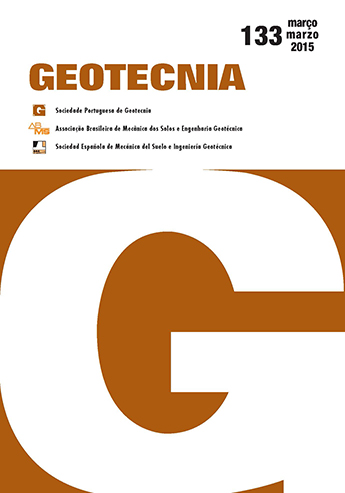Estimating the undrained shear strength from SPT energy dynamics
DOI:
https://doi.org/10.24849/j.geot.2015.133.03Keywords:
Undrained shear strength, Statistical adjustment, SPT, Pile driving energy, Energy efficiencyAbstract
This paper aims at developing a method to estimate the undrained shear strength (Su) using an approach based on the concepts of wave propagation theory applied to the SPT. A database for clay deposits was developed and used to support the analysis and proposed formulation. The method combines the theory for energy conservation with limit equilibrium analysis applied to the static load capacity of an isolated pile. From this approach, values of Su are predicted as a function of the coefficient of adhesion α obtained directly from the measured NSPT blow count derived from statistical analysis. The proposed method gives estimates of Su in the range of measured field values, with a coefficient of correlation (r2) of 0.65%, which reflects the inherent scatter of SPT measurements.
Downloads
References
Almeida, M.S.S.; Marques, M.E.S. (2002). The behavior of Sarapuí soft organic clay. Proc. International Workshop, vol. 1, pp. 447-504, Singapore.
ARUP (1992). Geotechnical interpretative report. Sectional Interpretative report 1 of 2. Torquay Street to Charing Cross Road. Part B: Results of ground investigations. Ove Arup & Partners, London.
Aschuri, I.; Hetty, S. (2001). Correlation studies between standard penetration test and self boring pressuremeter test on tropical residual soils. International Conference on In Situ Measurement of Soil Properties and Case Histories - Bali, Indonesia, pp. 571-576.
BS 1377-9 1990 (1998). Methods of test for soils for civil engineering purposes – Part 9: In-situ tests. British Standards Institution, London.
BS 4019-5 1999 (1999). Rotary core drilling equipment – Specification for wireline diamond drilling equipment – System A. Metric units. British Standards Institution, London.
Clough, R.W.; Penzien, J. (1975). Dynamic of Structures. McGraw-Hill, Inc., New York.
Collet, H.B. (1978). Ensaios de palheta de campo em argilas moles da baixada Fluminense. Dissertação de Mestrado, Universidade Federal de Rio de Janeiro, COPPE, Rio de Janeiro.
Doherty, P.; Gavin K. (2011). The shaft capacity of displacement piles in clay: a state of the art review. Journal Geotechnical and Geological Engineering, vol. 29, n° 4, pp. 389-410.
Hallal, R.R. (2003). Características de depósitos de argilas moles no estado do Rio Grande do Sul. Dissertação de Mestrado, Universidade Federal do Rio Grande do Sul, Porto Alegre.
Hermansson, I.; Grävare, C.J. (1978). Static Bearing Capacity of Piles from Dynamic Measurements. Särtyck ur Väg-och vattenbyggaren, v. 1, pp. 8-9.
Jannuzzi, G.M.F. (2009). Caracterização do Depósito de Solo Mole de Sarapuí II através de ensaios de campo. Dissertação de Mestrado, Universidade Federal de Rio de Janeiro, COPPE, Rio de Janeiro.
Kormann, A.C.M. (2002). Comportamento Geomecânico da Formação Guabirotuba: Estudos de Campo e Laboratório. Tese de Doutorado, Escola Politécnica de São Paulo, São Paulo.
Lobo, V.O. (2005). Método de previsão de Capacidade de Carga de Estacas: Aplicação dos Conceitos de Energia do Ensaio SPT. Dissertação de Mestrado, Universidade Federal do Rio Grande do Sul, Porto Alegre.
Muñoz-Rodríguez, C.A. (2012). Estimativa da Resistencia não Drenada (Su) Mediante o Cálculo da Energia de Cravação do SPT. Dissertação de Mestrado, Universidade Federal do Rio Grande do Sul, Porto Alegre.
NBR 6484 (2001). Solo – sondagem de simples reconhecimento com SPT: método de ensaio. Associação Brasileira de Normas Técnicas, Rio de Janeiro.
Odebrecht, E. (2003). Medidas de energia no ensaio SPT. Tese de Doutorado, Universidade Federal do Rio Grande do Sul, Porto Alegre.
Ortigão, J.A.R. (1980). Aterro experimental levado a ruptura sobre argila cinza do Rio de Janeiro. Tese de Doutorado, COPPE-UFRJ, Rio de Janeiro.
Poulos, H.G.; Davis, E.H. (1980). Pile foundation analysis and design. The University of Sydney, pp. 18-51.
Randolph, M.F. (2004). Characterization of soft sediments for offshore application. 2nd International Conference on Site Characterization, Milpress, Porto, 1: pp. 209-232.
Schmertmann, J.; Palacios, A. (1979). Energy Dynamics of SPT. American Society of Civil Engineers, v. 105, n.8, pp. 909-926.
Schnaid, F. (2001). Aeroporto internacional Salgado Filho Infra-Estrutura civil e geotécnica. Editora Sagra Luzzatto, Porto Alegre.
Schnaid, F.; Odebrecht, E.; Rocha, M.; Paula Bernardes, G. (2009). Prediction of Soil Properties from the Concepts of Energy Transfer in Dynamic Penetration Tests. Journal of Geotechnical and Geoenvironmental Engineering, 135(8), pp. 1092–1100.
Seed, H.B.; Tokimatsu, K.; Harder, L.; Chung, R. (1985). Influence of SPT Procedures in Soil Liquefaction Resistance Evaluations. Journal of Geotechnical Engineering, v. 111, n. 12, pp. 1425-1445.
Skempton, A.W. (1951). The bearing capacity of clays. Proc. Building Research Congress, Div. I Part III, London, pp. 180-189.
Skempton, A.W. (1986). Standard Penetration Test Procedures and the Effects in Sands of Overburden Pressure, Relative Density, Particle Size, Ageing and Overconsolidation. Géotechnique 36, n. 3, pp. 425-447.
Soares, J.M.D. (1997). Estudo do comportamento geotécnico do depósito de argila mole da Grande Porto Alegre. Tese de Doutorado, Universidade Federal do Rio Grande do Sul, Porto Alegre.
Terzaghi, K.; Peck, R.B. (1967). Soil Mechanics in Engineering Practice. 2nd ed. John Wiley and Sons, New York.




